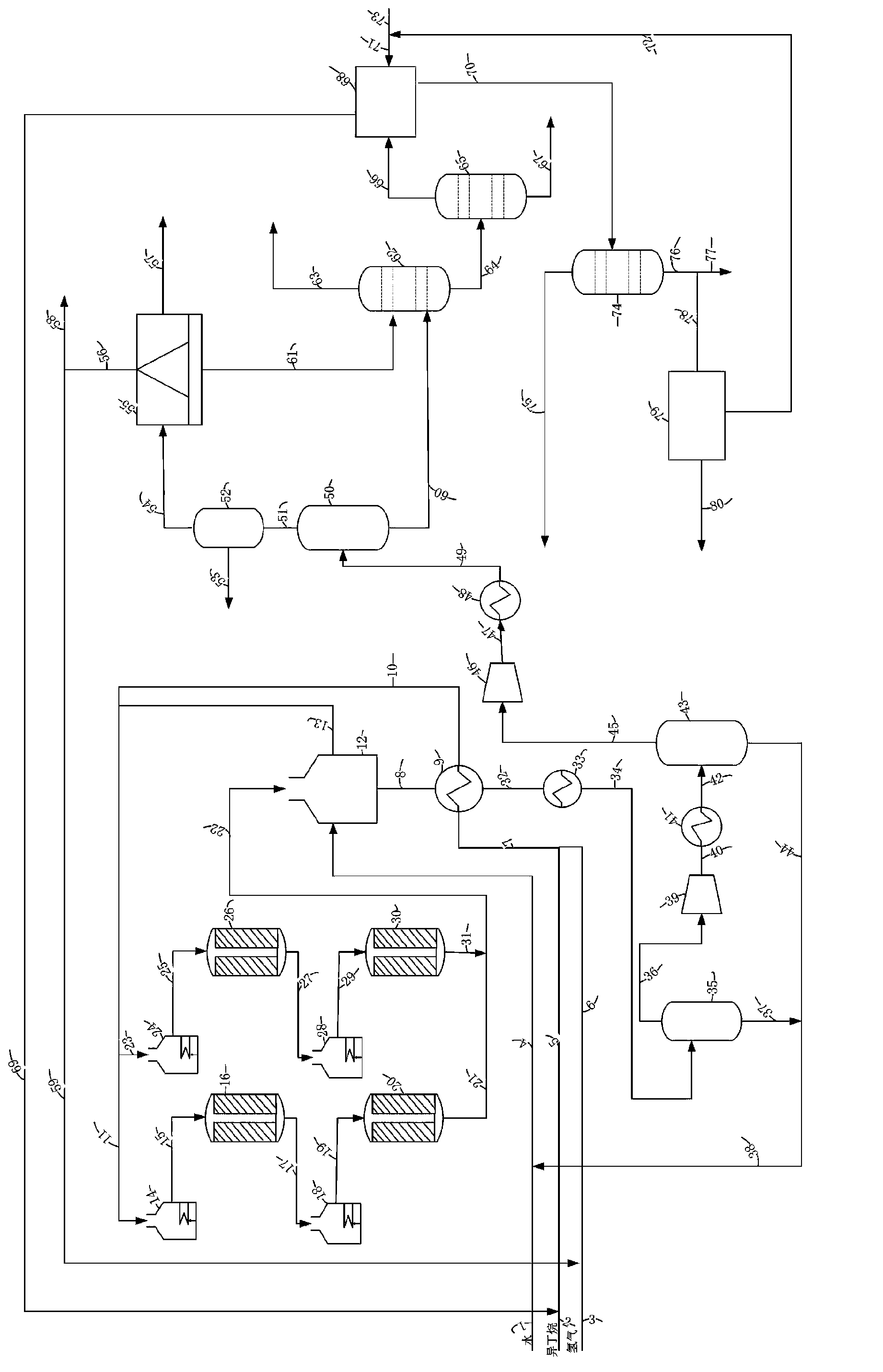Device and process for preparing isobutylene by dehydrogenating isobutane
A technology for isobutene and isobutane is applied in the field of isobutene dehydrogenation to produce isobutene reaction and product recovery, which can solve problems such as environmental hazards and achieve the effect of inhibiting coking reaction.
- Summary
- Abstract
- Description
- Claims
- Application Information
AI Technical Summary
Problems solved by technology
Method used
Image
Examples
Embodiment 1
[0062] Raw material isobutane 2, diluent H 2 3 and H 2 O1 exchanges heat with the high-temperature stream from the dehydrogenation reactor through the cooling heat exchanger I9 and the steam generator 12, and then enters the heating furnace I14 to be heated to 610°C to obtain isobutane, H 2 and H 2 High temperature stream 15 of O mixture. Stream 15 enters the dehydrogenation reactor I16, set the pressure of the dehydrogenation reactor to 0.3MPa, and the gas space velocity to 2500h -1 , the reaction feed gas volume ratio is isobutane: hydrogen: water vapor = 1:0.5:1.5, under the action of the platinum series catalyst with Pt-Sn-K as the active component suggested by the patent CN102000593, part of the isobutane is removed Hydrogen forms isobutene. The stream coming out of the dehydrogenation reactor I16 enters the heating furnace II18 to heat the gas flow to 600°C and then enters the dehydrogenation reactor II20. The pressure of the dehydrogenation reactor II is set at 0.25...
Embodiment 2
[0072] Raw material isobutane 2, diluent H 2 3 and H 2 O1 exchanges heat with the high-temperature stream leaving the dehydrogenation reactor through the cooling heat exchanger I9 and the steam generator 12, and then enters the heating furnace I14 to be heated to 630°C to obtain isobutane, H 2 and H 2 High temperature stream 15 of O mixture. Stream 15 enters the dehydrogenation reactor I16, set the pressure of the dehydrogenation reactor to 0.5MPa, and the gas space velocity to 4000h -1 , the reaction feed gas volume ratio is isobutane: hydrogen: water vapor = 1:0.5:1.0, part of the isobutane is removed under the action of the platinum catalyst with Pt-Sn-K as the active component suggested by the patent CN102000593 Hydrogen forms isobutene. The stream coming out of the dehydrogenation reactor I16 enters the heating furnace II18 to heat the gas stream to 630°C and then enters the dehydrogenation reactor II20. The pressure of the dehydrogenation reactor II is set at 0.4 MPa...
Embodiment 3
[0082] Raw material isobutane 2, diluent H 2 3 and H 2 O1 exchanges heat with the high-temperature stream from the dehydrogenation reactor through the cooling heat exchanger I9 and the steam generator 12, and then enters the heating furnace I14 to be heated to 640°C to obtain isobutane, H 2 and H 2 High temperature stream 15 of O mixture. Stream 15 enters the dehydrogenation reactor I16, the pressure of the dehydrogenation reactor is set to 0.35MPa, and the gas space velocity is 5000h-1 , the reaction feed gas volume ratio is isobutane: hydrogen: water vapor = 1:1:1, under the action of the platinum series catalyst with Pt-Sn-K as the active component suggested by patent CN102000593, part of the isobutane is removed Hydrogen forms isobutene. The stream coming out of the dehydrogenation reactor I16 enters the heating furnace II18 to heat the gas flow to 650°C and then enters the dehydrogenation reactor II20. The pressure of the dehydrogenation reactor II is set to 0.3MPa to ...
PUM
 Login to View More
Login to View More Abstract
Description
Claims
Application Information
 Login to View More
Login to View More - R&D
- Intellectual Property
- Life Sciences
- Materials
- Tech Scout
- Unparalleled Data Quality
- Higher Quality Content
- 60% Fewer Hallucinations
Browse by: Latest US Patents, China's latest patents, Technical Efficacy Thesaurus, Application Domain, Technology Topic, Popular Technical Reports.
© 2025 PatSnap. All rights reserved.Legal|Privacy policy|Modern Slavery Act Transparency Statement|Sitemap|About US| Contact US: help@patsnap.com

